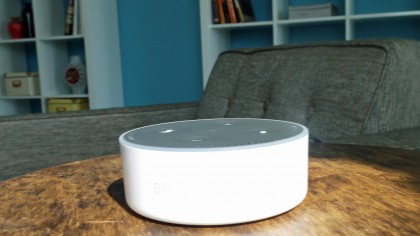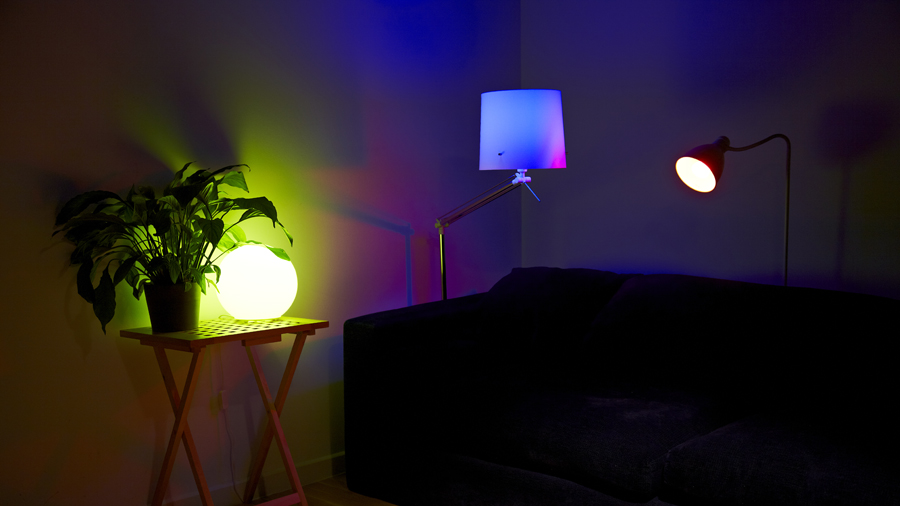Why you can trust TechRadar
Philips Hue app
Philips has worked hard to develop its app, which has seen a great deal of improvement in the years since the smart bulb’s initial release.
The default home screen shows you your available rooms, allowing you to control all their bulbs as a group. You can tap on the switch to the right of the screen to turn them on to their last setting.

But, if you’re using the default settings, you’re nowhere near using the Philips Hue bulbs to their potential.
The real fun starts when you tap the room’s icon on the left of the screen, which allows you to customize the exact bulb color.
The easiest way to do this is with Philips’ pre-configured scenes, which range from ‘Spring Blossom’ (a cool, white light) through to ‘Savanna Sunset’ (a much richer yellow hue).
We found ourselves relying mostly on the activity-specific defaults. ‘Energize’ was perfect for the mornings when the harsh white light worked well to blow away the cobwebs, while ‘Relax’ worked better in the evenings where we wanted our brains to wind down.

If you want to get really granular you can adjust specific settings to create your own scenes, or even have the Hue app create a light scheme based on an imported picture.
Sign up for breaking news, reviews, opinion, top tech deals, and more.
This additional functionality is appreciated, but in practice we didn’t feel the need to use it much. After all, there are only so many different shades of yellow to experiment with before the novelty wears off.
The exception was using the lights to play around with bright, primary colors. We can’t ever see ourselves using these in our everyday lives, but they’d make a perfect accessory for a party atmosphere.
Of much great importance is the routines section of the app. From here you’ll be able to set the lights to automatically turn on and off when you arrive at, and subsequently leave, the house, as well as allowing you to have the lights turn on and off automatically at different times.
By way of an example, we had the lights turn on to help us wake up in the morning, before automatically turning off when we left the house for work. In the evening we then had the lights turn back on when we arrived back at the house. You could also have the lights turn off automatically at a certain time, but we found it easier to do this manually.
Philips Hue smart switches
There are a couple of switches that Phillips has created to use with its Hue bulbs. As we mentioned earlier, these enable you to control the bulbs without using the app.
This not only saves you from having to reach for your smartphone, but it means guests who don't have the app can still control the lights.
The first switch is the Philips Hue Tap Switch, which sells for $49.99 (£49.99, AU$79.95), and comes with four buttons. These buttons can be assigned to the scenes you’ve previously created, allowing you to quickly switch between light settings. You can also assign a button to turn off and on the lights. These settings are configured via a separate app.

The design of the Hue Tap switch is quite pleasant, with three reasonable-sized buttons in the lower half of the device’s body. The fourth button is actually the entire face of the switch, which can be pressed in. However, while the design is nice, it does not look like a traditional light switch, which has a tendency to confuse visitors who don’t know what the device is for.
The Philps Hue Tap Switch is easily installed, as it comes with adhesives on the back that allow you to stick it to walls and other surfaces. It does not require batteries either - instead it uses the kinetic energy created when you push the buttons for power, which is pretty nifty.
The second switch is the Philips Hue Dimmer Switch, which has a more simple - and identifiable - design. It doesn’t have the complexity of the Tap Switch, and simply dims or brightens connected lights, or turns them on or off. It’s also more affordable, selling for $24.99 (£19.99, AU$34).
Third-party integration
These integrations let you use a dizzying number of devices to control your lights, meaning that if you ask ten different Philips Hue owners how they control their smart lights you’ll probably get ten different answers depending on which accessories they have connected and which phone operating system they use.
Our primary reviewer was using an iPhone SE as their main means of controlling their lighting setup. This meant that they had the option of jumping into the app to turn on their lights, or else control them from the phone’s control center menu via their HomeKit integration.
They also got their Hue lights connected to an Amazon Echo Dot to allow for voice control.

Doing so was a matter of logging into a Hue account from within the Alexa app, after which point controlling the lights was as simple as asking Alexa to turn certain rooms on or off.
A quick word of warning that you need to be sure to give each of your rooms a name that’s distinct and easy to pronounce. It might be convenient to simply name your bedroom ‘Bedroom’, but this will quickly become confusing as soon as you equip other bedrooms in your house with Hue lights.
Meanwhile, another of our reviewers used the Nuimo - Smart Home Controller to control some Hue lightbulbs.
This is a nicely designed (and pricey) controller, that worked well in some senses. However, it requires a Bluetooth connection to a smartphone with the Hue app installed, which makes things a little convoluted.
If that phone is not in range, the controller doesn’t work. There is also a delay when using the Nuimo to control Hue, due to the controller having to communicate with the smartphone and then the app.
It should be noted that this is a design flaw with Nuimo, rather than Hue. However, we’d suggest Philip’s own switches for quick control of Hue. They are easier to install and cheaper.
Current page: App, smart switches and third-party integration
Prev Page Introduction, lineup, setup and installation Next Page Daily use and performance
Over the last several years, Mark has been tasked as a writer, an editor, and a manager, interacting with published content from all angles. He is intimately familiar with the editorial process from the inception of an article idea, through the iterative process, past publishing, and down the road into performance analysis.
